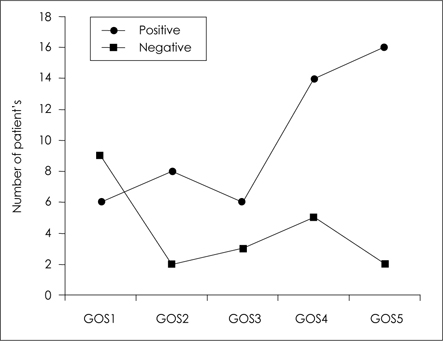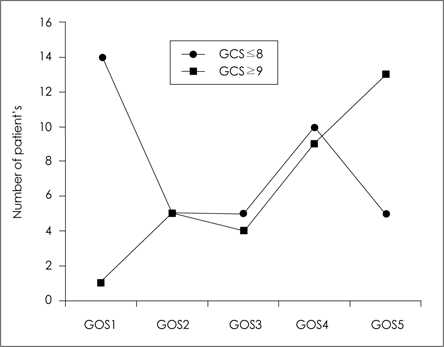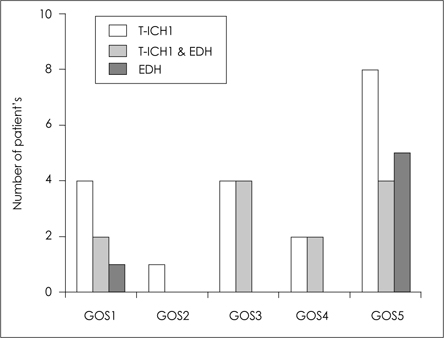Abstract
Objective
In order to present statistical evaluation on the prognosis and surgical outcome of acute subdural hemorrhage (SDH), and concomitant epidural hemorrhage (EDH) and/or concomitant traumatic intracerebral hemorrage (T-ICH), we report the analysis of clinical findings and treatment results with literature.
Methods
We retrospectively analyzed for 71 cases of 466 acute SDH cases that treated in Gyeoungsang National University Hospital from January 2006 to December 2008 by medical record. We analysed the age, gender, initial Glasgow Coma Scale (GCS) on admission, pupil light reflex, the time from emergency room to operation room, according to pastient's Glasgow Outcome Scale (GOS). We used computed tomography (CT) scan to investigate the presence of concomitant EDH, T-ICH, presence of midline shifting. hemorrhage depth. We also took interest in effect of location of concomitant hemorrhage on patient's GOS.
Results
There was stastistically significant correlation the age, GCS, pupil light reflex, concomitant bilateral hemorrhage unrelated with subtype with patient's outcome (GOS) but other's parameters (midline shifting, the time from emergency room to operation room) have no statistical significance correlation with patient's outcome.
Conclusion
This study showed that the factors like age, GCS on admission, and pupil light reflex were related to the prognosis of the patients with acute SDH, and involving bilateral hemorrhage, instead of unilateral, illustrated outcomes in any type of intracranial hemorrhage. We think that a futher study would be performed that includes amount of hemorrhage, location of hemorrhage, and a larger number of patients for statistical plausibility.
REFERENCES
1. Becker DP, Miller JD, Ward JD, Greenberg RP, Young HF, Sakalas R. The outcome from severe head injury with early diagnosis and intensive management. J Neurosurg. 1977; 47:491–502.

2. Britt RH, Hamilton RD. Large decompressive craniectomy in the treatment of acute subdural hematoma. Neurosurgery. 1978; 2:195–200.
3. Bullock MR, Chesnut R, Ghajar J, Gordon D, Hartl R, Newell DW, et al. Surgical management of acute subdural hematomas. Neurosurgery. 2006; 58:S16–S24.

4. Chesnut RM, Marshall LF, Klauber MR, Blunt BA, Baldwin N, Eisenberg HM, et al. The role of secondary brain injury in determining outcome from severe head injury. J Trauma. 1993; 34:216–222.

5. D'Amato L, Piazza O, Alliata L, Sabia G, Zito G, Frassanito L, et al. Prognosis of isolated acute post-traumatic subdural hematoma. J Neurosurg Sci. 2007; 51:107–111.
6. Dent DL, Croce MA, Menke PG, Young BH, Hinson MS, Kudsk KA, et al. Prognostic factors after acute subdural hematoma. J Trauma. 1995; 39:36–42.

7. Grant PT, Henry JM, McNaughton GW. The management of elderly blunt trauma victims in Scotland: evidence of ageism? Injury. 2000; 31:519–528.

8. Haselsberger K, Pucher R, Auer LM. Prognosis after acute subduralor epidural hemorrhage. Acta Neurochir (Wien). 1988; 90:111–116.
9. Hukkelhoven CW, Steyerberg EW, Rampen AJ, Farace E, Habbema JD, Marshall LF, et al. Patient age and outcome following severe traumatic brain injury: an analysis of 5,600 patients. J Neurosurg. 2003; 99:666–673.

10. Jamjoom A, Nelson R, Stranjalis G, Wood S, Chissell H, Kane N, et al. Outcome following surgical evacuation of traumatic intracranial haematomas in the elderly. Br J Neurosurg. 1992; 6:27–32.

11. Jang HS, Lee YB, Chung C, Lee KC, Park YS, Mok JH. Acute subdural hematoma: an analysis of 244 operated cases. J Korean Neurosurg Soc. 1996; 25:111–118.
12. Kim ST, Lee JS, Kwon IS, Hong SK, Moon MS. Clinical survey of intracranial acute subdural hematoma. J Korean Neurosurg Soc. 1990; 19:70–78.
13. Lee K, Lee KS, Bae HG, Yun IG, Lee IS. Characteristics of head injury in the aged. J Korean Neurosurg Soc. 1990; 19:1001–1008.
14. Lee KS, Bae HG, Yun IG. Acute subdural hematoma: analysis of 183 operated cases. J Korean Neurosurg Soc. 1992; 21:983–989.
15. Lee SW, Kim OL, Woo BG, Kim SH, Bae JH, Choi BY, et al. Prognostic factors in patients with severe head injury. J Korean Neurosurg Soc. 1999; 28:1288–1292.
16. Massaro F, Lanotte M, Faccani G, Triolo C. One hundred and twentyseven cases of acute subdural hematoma operated on Correlation between CT scan findings and outcome. Acta Neurochir (Wien). 1996; 138:185–191.
17. Mosenthal AC, Lavery RF, Addis M, Kaul S, Ross S, Marburger R, et al. age is an independent predictor of mortality and early outcome. J Trauma. 2002; 52:907–911.
18. Ono J, Yamaura A, Kubota M, Okimura Y, Isobe K. Outcome prediction in severe head injury: analyses of clinical prognostic factors analyses of clinical prognostic factors. J Clin Neurosci. 2001; 8:120–123.
19. Sawauchi S, Abe T. The effect of haematoma, brain injury, and secondary insult on brain swelling in traumatic acute subdural haemorrhage. Acta Neurochir (Wien). 2008; 150:531–536.

20. Seelig JM, Becker DP, Miller JD, Greenberg RP, Ward JD, Choi SC. Traumatic acute subdural hematoma: major mortality reduction in comatose patients treated within four hours. New Engl J Med. 1981; 304:1511–1518.
21. Servadei F. Prognostic factors in severely head injured adult patients with acute subdural hematomas. Acta Neurochir (Wien). 1997; 139:279–285.
22. Statham PF, Johnston RA, Macpherson P. Delayed deterioration in patients with traumatic frontal contusions. J Neurol Neurosurg Psychiatry. 1989; 52:351–354.

23. Stone JL, Lowe RJ, Jonasson O, Baker RJ, Barrett J, Oldershaw JB, et al. Acute subdural hematoma: direct admission to a trauma center yields improved results. J Trauma. 1986; 26:445–450.

24. Taussky P, Widmer HR, Takala J, Fandino J. Outcome after acute traumatic subdural and epidural haematoma in Switzerland: a single centre experience. Swiss Med Wkly. 2008; 138:281–285.
25. Yoon SM, Lee KS, Lee JH, Doh JW, Bae HG, Yun IG. Surgical outcome following evacuation of traumatic intracranial hematomas in the elderly. J Korean Neurosurg Soc. 2003; 33:477–482.
FIGURE 1.
Surgical outcomes considering initial GCS on overall outcome (p=0.001). GOS: Glasgow Outcome Scale, GCS: Glasgow Coma Scale.

FIGURE 2.
Surgical outcomes considering pupil reflex (p=0.008). GOS: Glasgow Outcome Scale, GCS: Glasgow Coma Scale.

FIGURE 3.
Surgical outcomes considering concomitant hemorrhage (p=0.70). T-ICH: traumatic intracerebral hemorrhage, GOS: Glasgow Outcome Scale, EDH: epidural hemorrhage.

Table 1.
Surgical outcomes considering various factors




 PDF
PDF ePub
ePub Citation
Citation Print
Print


 XML Download
XML Download